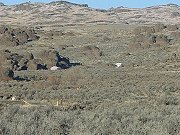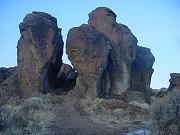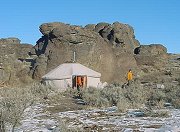| From Strugglingteens.com Visit Reports Gooding, Idaho Bundled up against the cold on a high plateau where SUWS operates near Sun Valley, Idaho, the kids in the program reminded me of grade school kids with multiple layers of clothing put on by their mothers to go outside to play. These students were dressed plenty warm for the cold front coming through. They seemed to take the cold in stride and cheerfully (most of them) maintained their usual daily routines.
The children are divided into several groups consisting of no more than seven students each. In my tour I had a chance to visit several groups scattered around the high plateau rocky landscape, and in each, the students explained their stories about how they had come to be enrolled in SUWS, and what they were learning there, which of course included ďnot muchĒ with a couple of the newer students. The groups have no contact with each other except when a student has done well and is almost ready to graduate, they join the Search and Rescue (S & R) team, which interacts with the various groups to provide leadership and example, and prepares for any real Search and Rescue efforts that might be needed in the area. SUWS uses the S & R metaphor as the framework for their program. The metaphor of course relates to helping the student in his/her own out-of-control behavior and having lost their way in growing up. In the final step of the program, S & R changes from metaphorical and figurative to literal. Part of the tasks for each student is to learn wilderness techniques in searching for a reported accident and then performing the required rescue operations. Students are provided with opportunities to sacrifice their own wants to serve someone else. Itís about giving back. Visiting professionals are routinely asked to play the part of an accident victim so the S & R team can practice. In my case, they used makeup to put some blood and bruises on my head and instructed me to sit in the driverís seat of the pickup and act dazed, confused and uncertain of what was going on, as in a possible concussion. (This was not very hard to do, and I suspect the staff might have had some kind of typecasting in mind.) A report of an accident went out on the radio, and soon the group showed up on the horizon and pushed through the sagebrush to the scene. One student read from a checklist of symptoms, while the other students gently pushed, poked, prodded or responded with an answer. The list seemed to be well thought out in design to give clues as to the type and extent of the injury and what first aid might be needed. Soon, the staff called off the exercise, and we all stood around debriefing how they handled it. Considering the students for the most part had been city kids not too many weeks before, I was impressed at how well they had adapted to living in the wilderness and handling what might have been a serious accident. By the way, I understand that from time to time the S & R team is called out to help with a real emergency as in a lost and/or injured hunter or hiker.
When a student first enrolls, he/she is placed in the first group for about a week, which is composed exclusively of new students. This orientation time under the very watchful eye of the instructors gives the students a chance to adjust to this new lifestyle, learn basic wilderness skills, and gives the staff a chance to do a tentative assessment and get a sense of what each studentís issues are. If a student is very inappropriate for a wilderness experience, this is part of what the staff is looking for in this first group. After the first week, the student is assigned to their permanent group, based largely on the issues of the student and where he/she might best be able to work on them. The student then stays with this group the rest of his/her stay with SUWS, until they might be selected for S & R activities. On occasion, a student is transferred to a different group when his/her issues would be better addressed in another group. By establishing this initial group, the program is able to handle rolling admissions, which means a student can be enrolled any day of the week. It also allows more flexible lengths of stay, which a better opportunity for meeting the needs of each child. The staff emphasizes that one of their most important perspectives is to listen to what the student has to say, and they work hard to avoid a common mistake made by some therapists who project their own assumptions onto the students. They believe that one way or another, through words or behavior, the student will let the staff know what the problem is. The program also has a level system each student goes through. Each level is named after the characteristics of animals that seem to most closely reflect the power and vulnerabilities of those animals. Each student starts at the mouse level, and as they grow in responsible behavior, they move up through raccoon, frog and finally to the eagle level.
The student activities and location vary with the seasons. They use lower elevations during the winter and move to higher elevations during the heat of summer. During the winter, while I was there, the students did move locations, but in their daily activities they did not range far from the tent or yurt that is the center of their activities. During warmer seasons, the students can range further from their base camp shelter.
One of the groups I visited was the Youth Group, for students 11-13. Since pre-teens have somewhat different requirements than teens, the younger students have their own separate group, and are separated from the other groups as they develop their own approach. One of the significant differences is the Youth Group uses Llamas in their program, as a form of animal therapy. Even though SUWS has been operating continuously for 23 years, they are still changing and adapting their program to the ever-changing needs of their students, and in my experience with them, they still provide significant impact on the attitudes of their students. © Copyright 2012 by Woodbury Reports, Inc. |



